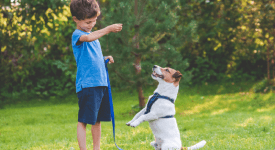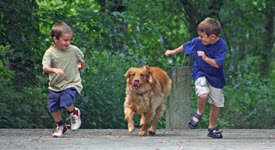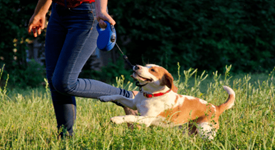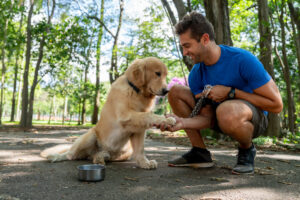There are several ways to define a dog’s (or puppy’s) behavior, but one of the ways behavior can be defined is the way an animal or human reacts to a particular situation (or stimulus). Behavior Modification then is the systematic approach to changing unwanted behavior.
In other words, unlike dog obedience training that trains a dog to perform specific actions when requested, ideally behavior modification looks to change a dog’s reaction to a situation, a person, an object, another animal, and so on.
While some behavior modification makes use of obedience training techniques such as teaching a dog to sit or lie down, these taught behaviors are called on as tools in an overall program that hopes to change how the dog thinks, feels, and acts. Lying down and “sit-stay” (where the dog sits when asked and stays seated until given the signal to go) may encourage self-control, deference, or relaxation for example, in combination with other methods.
These behaviors can be helpful, but not if we are only focusing on what the dog does, and not what is going on inside, why it happens, when it happens, and what it looks like before the unwanted behavior (e.g.: dog aggression) starts. We need to set up our dog for success.
Dangers of Focusing Only on What the Dog Does
- People solely focus on what the dog is doing and ignore the internal process that needs to be addressed, such as anxiety and the dog’s physical responses (e.g.: the fight or flight response of the nervous system).
- People skip or ignore the two most fundamental aspects in addressing dog aggression:
- Avoiding the triggers that cause the aggression
- Foundation training allowing the behavior modification process to become possible
Changing the Behavior and the Attitude
It is important for people to understand that when we try to treat dog aggression, we are looking to change more than simply what the dog does. Sometimes it is possible to temporarily suppress aggression, but unless you treat the underlying problem, the problem can get worse in the long-term.
We are looking to change the attitude as well so that the dog is no longer anxious. To change the attitude means giving our dogs every chance to succeed. We need to understand how to read the subtle behaviors that are showing our dogs are uncomfortable, and they need to understand exactly what is expected of them – and they need to be able to do it. You can’t expect a child to read a book until they have learned the alphabet.
In many cases people instinctively start giving dogs treats in hopes to change the dog’s attitude without realizing that the dog is simply far too anxious to even enjoy the treat, let alone have a complete change of mind about the thing that is making him aggressive.
So while it’s possible to change dog aggression, you can’t really just wing it and figure it out as you go. You need to be taught. That’s where private one-on-one dog training comes in. If you are struggling with dog behavior modification, please give me a call or request a free consultation.









